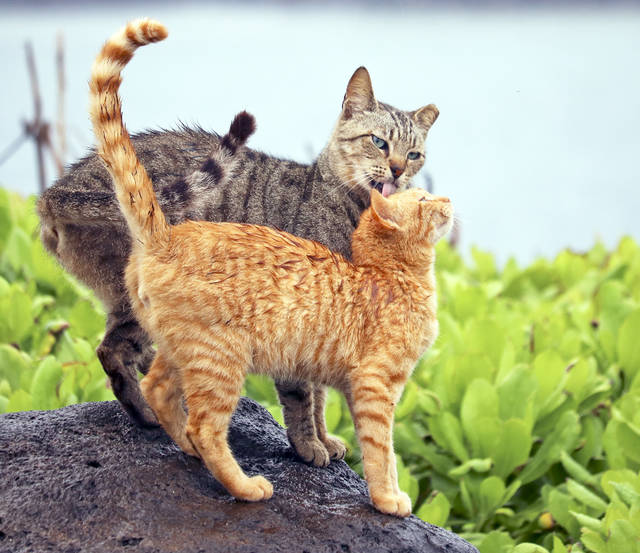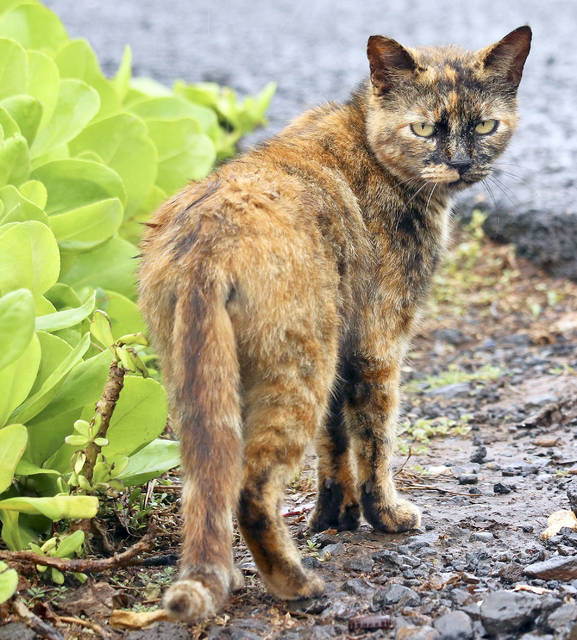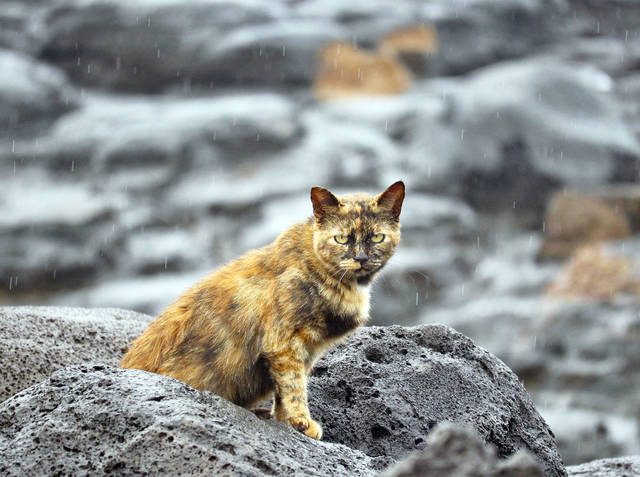LIHUE — The number of feral cats has declined on Kauai in the past five years and though the pace has slowed in 2018, there are still more than 3,000 urban feral cats on the island.
The ideal number might not be zero, though, according to Kauai animal advocates, who say cats can have positive impacts on their communities, if the population is kept in check.
“While it’s hard to say what an ideal number of community cats might be, that number is certainly greater than zero, but far fewer than we have today,” said Basil Scott of Kauai Community Cat Project.
He continued: “Many people like having cats around, and some businesses also like cats as ratters — working cats — for example.”
Dinah Chao of Kauai Animal Welfare Society said the organization isn’t taking adult cats at the present, but has been able to take in and tame kittens from feral colonies as space allows.
“Feral cats can be adopted to barn cat locations. Young feral kittens can be tamed and adopted out as pets,” she said. “Community cats are beneficial in rodent control. As long as a colony is maintained and kept healthy, fed, spayed and neutered, feral cats do an amazing job of rodent control.”
KAWS hasn’t heard any official reports of declining feral cat population, but in the colonies the organization helps manage on private properties, the numbers have remained steady or declined.
Overpopulation of feral cats brings the potential for disease to the human population and poses a problem for native and endangered birds.
Toxoplasmosis is a disease that can affect all mammals and birds. The parasite requires a feline digestive system to repopulate. However, data shows there have been zero reports of human cases on Kauai since 2009.
An overpopulation of community cats clogs up the Kauai Humane Society, which is an open-intake shelter that routinely accepts stray cats and dogs, though not every stray cat that’s taken in is a feral.
KHS doesn’t break down its data to identify the number of truly feral cats taken in, but they do calculate the number of strays taken in, as well as the number of cats euthanized annually.
In 2013, KHS received 2,487 stray cats. That number decreased to 2,301 in 2014, then to 1,963 in 2015 and to 1,661 stray cats in 2016. In 2017, KHS took in 2,063 stray cats.
Of those cats, 2,042 were euthanized in 2013, 2,027 were euthanized in 2014, 1,607 were euthanized in 2015, 1,183 were euthanized in 2016 and 1,389 were euthanized in 2017.
The contract between KHS and the County of Kauai animal control is the reason KHS is the end point for many of these stray cats, though KHS’s priority is to serve the community through animal care and adoption programs too, according to Diann Hartman, president of the KHS board of directors.
Space is limited in the shelter. Because it also accepts feral cats surrendered by the community, it can get cramped, as often happens in the summer during kitten season.
“Hopefully the number of feral cats is decreasing due to spay/neutering and caregivers of community cats being responsible with their cats, catching them and sterilizing them,” Hartman said.
She said the guidance and assistance provided by KCCP to these community cat caretakers is an aid in the mission to control the population.
All of the cats that are surrendered to KHS go through a list of criteria that funnels them into one of two categories: those that fit into the adoption program and those that don’t.
Hartman said KHS staff members work on finding homes for all of the animals that go into the shelter, though most animals that display vicious behavior are euthanized.
“Some (that don’t qualify) due to injury or illness will try to be cared for through foster or transferred to a partner organization,”
she said.
Once a cat is surrendered to KHS, staff members start their analysis. Age is one of the first questions. If the kittens are under eight weeks of age or under two pounds, the search is on for foster families.
“We try and find foster homes for these, particularly if they are weaned,” she said.
Those with extreme medical conditions and physical problems are transferred to Mainland partners that can provide surgeries when possible, though all animals must pass behavior tests.
Animals that show stress in a kennel environment are fielded out to foster homes when possible. Dogs are usually the ones that exhibit kennel stress.
“We also have a number of partners on the Mainland that accept shy dogs,” Hartman said.
When it comes to community cats, KCCP focuses on a trap, neuter, release policy on urban cats and tracks their progress. According to the organization, there was between a 1 and 2 percent decline in cat numbers in 2017.
Data showed that two-thirds of the population decline seen from 2016 to 2017 was due to the ongoing spay/neuter program, and one third of the decline was due to trapping and removing animals.
“Removing cats takes away those specific animals, but the population rebounds in as little as four months because of the cats’ high reproductive rate and new animals entering the ‘cleaned out’ area,”
Scott said.
Hartman pointed to KCCP data which shows when the organization successfully sterilizes a community cat colony, they see a 20 percent reduction in population for that group in about a year.
“Targeting areas and groups of cats can clearly be effective at reducing numbers,” Hartman said.
In 2017, KHS provided 1,500 free sterilization surgeries. Scott said that helped with overall cat population control, but also shows the need for that kind of surgeries.
According to anecdotal accounts, the recent Mobile Animal Sterilization Clinics with Animal Balance helped the numbers as well, but data from the MASH Clinics hasn’t yet been compiled.
The optimal number of feral cats is a hard number to define, according to animal advocates on Kauai, but Scott said KCCP’s general goal is to have about 2,500 urban cats on the island.
That’s a 75 percent reduction from current numbers, and matches the estimated number of cats living in Kauai’s wild interior and on the wild coastlines.
“To achieve a 75 percent reduction goal, we would need far greater availability of spay/neuter services for the island,” Scott said. “Almost all of this capacity would be for pets or cats kept outside on private property, as the attendance at MASH Clinics has demonstrated.”
•••
Jessica Else, environmental reporter, can be reached at 245-0452 or jelse@thegardenisland.com








Feel sorry for the cats but not those awful chickens.
The target number of cats ( Not “Community Cats” as Cat groups want to brainwash you with….These are feral invasive animals ) is Zero.
No TNR and no spread of disease to humans and wildlife.
No more mass murder of rare birds.
Enough with this outside hoarding habit on these beautiful islands.
How about zero humans instead? Humans are the problem. Especially closed minded selfish ones as yourself.
Not a single word about endangered birds or the effects of toxoplasmosis on monk seals. That’s irresponsible reporting Jessica. Where’s the “other side” of this story? No mention of feral cats being added to the invasive species list? Wow. This is what passes as journalism now eh? Sad.
All wildlife spread diseases to humans and other wildlife and cats are not the only animal to prey on birds.
These cat societies are living in a fantasy world, there wasn’t any cats when Hawaiians ruled this island State and native birds actually thrived. But now they are threaten by feral cats who also produce Taxiplasma in their feces and urine that threaten and have killed a number of monk seals and other marine life. Humans also catch this neural brain disease causing paranoid and depression along with suicides. There are no such thing as a balance of feral cats, they do not belong in Hawaii period.
Hopefully people will realize that trap, neuter, return, of managed colonies is the ONLY way to go
I’ve tried to comment previously, and my comments don’t get posted. So, please excuse me ahead of time if it seems I am trying to make multiple comments, I am not. Public health is at stake and people using the recreation areas in Kauai, drinking the water, eating local produce, playing in recreational areas, all deserve accurate information about the ubiquitous presence of the cat parasite Toxoplasma gondii, due cats defecating into the environment there, and most places around the world. But the oocytes persist months to years in the soil and water, especially in tropical areas.
Reporting of Tg infections with pathology is not mandatory in the state of Hawaii and the state keeps no statistics. Toxoplasma gondii is a very complex parasite with a complicated life cycle. Saying that there has been no Tg infections since 2009 is flat out wrong and based on unavailable data. Also, clinical manifestation of infection with the cat parasite is highly varied, ranging from minor discomfort to fatal encephalitis, fetal demise, developmental perturbations, hearing loss, vision loss, hydrocephalus, microcephaly, brain calcifications with seizures, and more. In the USA, about 11% of people have been infected and about a million a year are newly infected, and Kauai, with its high number of free roaming cats is perfect for maintaining and spreading Tg oocytes. Claiming there are no recent infections is based on no data. Patients generally keep their medical information private and there is no mandatory reporting in Kauai or the state of Hawaii.
I agree that this is irresponsible reporting. Do people on the other side of the issue get to have their input?
Feral cats do not belong in the Hawaiian Islands and people are causing great damage to the environment by supporting these cat colonies.
Below is a link to actual scientific papers showing time and time again that TNR does NOT work.
http://www.hahf.org/awake/tnr-not-working/
What data did KCCP provide to backup their claims?
Proponents of feral cat communities say supporting them is the humane thing to do, but what about the conditions these cats live in? Most of the feral cats are not in good condition. And the native species these cats kill why don’t they deserve to live? Why is the life of a cat more important?
It amazes me that the county does nothing to remove feral cats like they do in many island environments.